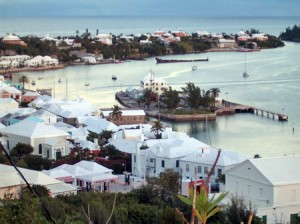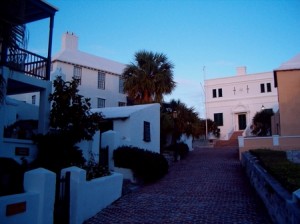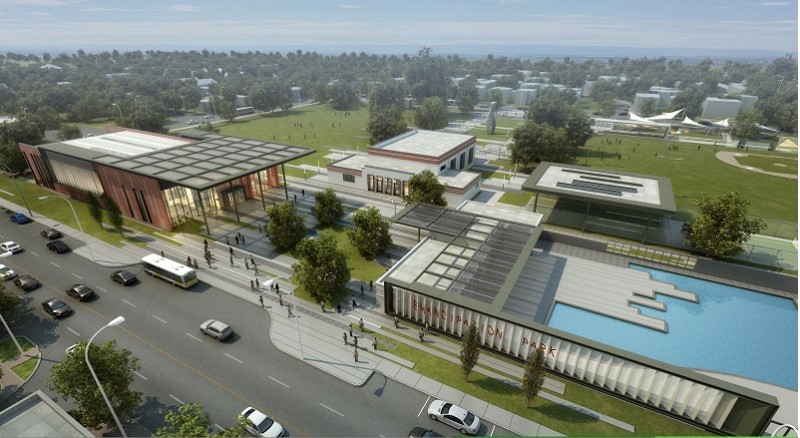Editor’s note: This post concludes a series commemorating the anniversary of the National Historic Preservation Act by examining a part article published in The Public Historian, describing its significance and relating it to contemporary conversations in historic preservation.
Clik here to view.

Harbor of Town of St. George, Bermuda, 2006.
Photo by Aodhdubh at English Wikipedia.
CC BY 2.5, https://creativecommons.org/licenses/by/2.5/.
Historic preservation exists to tell stories of our journeys as a people and as a nation, but somehow along the way the stories of America’s African American, Latino, Asian, and Native American communities are erased or obscured as historians and preservationists tell the great American story. As we celebrate fifty years of the 1966 National Historic Preservation Act (NHPA), America’s historical record overwhelmingly favors a well-to-do minority. This anniversary should be characterized by a rigorous assessment, inventory, and look back at what has been preserved and what has been ignored. The challenge is to ask: When the preservation of heritage is the vision of the privileged few, is the American public being served?
The call of those who are not the dominant voices in American memory resonates with the title of a Langston Hughes poem, “I, Too, Sing America,” a poem of people, communities, and histories left out of the nation’s collective story. It is a longing for inclusion. In this year of celebration, that historic poem challenges preservationists and historians to ensure a place for every American story because there’s damage to our national consciousness when a majority of the population is left out.
In “Emphasis on the Public,” Leondra Burchall shares how the preservation of buildings, museum exhibitions, historic writings, and academic histories can be disconnected from the way individuals and communities experience history. When the historical record reflects only the perspectives of the powerful, Burchall notes, underrepresented communities are left to admire from a distance. To close the distance and make history relevant to all, museum officials, academics, historians, and preservationists must eliminate cultural bias. Those same arbiters of history must examine their storytelling practices and make room for other voices in local, regional, and national narratives.
As a cultural activist, I have supported and advocated for efforts that reflect the inclusivity of community voices, experiences, and perspectives. My work that related to America’s civil rights legacy prompted congressional legislation to support museums and data collection that include marginalized communities. Engaging congressional leaders and state officials in conversations about America’s rich heritage, I focused on connecting diverse audiences. As an artist, literature allows me a path to partner arts and action.
Literature, poetry, and visual arts provide vibrant ways to engage audiences and experience national storytelling in new ways. Former US Poet Laureate Natasha Trethewey’s collection, Native Guard, offers a meditation on America’s past and a counter to the erasure of contributions of others, as if they played no role in America’s growth as a nation. Her poetry teaches us. As survivors, we have a duty to tend to the gravestones of our fathers and mothers and those who laid down their lives in building this country. The legacy we inherit is inscribed across many monuments, such as the little school houses, businesses, front porches, casitas, inns, farms, waterways, and mountains where people labored, raised their families, shared music, and passed down stories.
The late Dr. Clement Price, in his roles as Newark (NJ) Historian, member of the Advisory Council on Historic Preservation, and a Trustee of the National Trust for Historic Preservation, mentored me as a new preservationist. We shared African American traditions that valued ancestral knowledge and participation in family acts to preserve graves, churches, and cultural stories. In that regard, we both were raised in traditions that hold sensitivity for awareness and preservation, to save places that Price called “harbors for memory and ritual.” We learned through practice from people untrained in formal preservation techniques but who honored legacies.
Price inserted a new narrative into historic preservation in his essay, “The Path to Big Mama’s House: Historic Preservation, Memory, and African American History.” He wrote of a simple bungalow, built in about the 1920s in South Carolina, a place where he reflected on the deep, meaningful, and subtle ways “the power of place and a personal interest in preserving places and memories” dear to him shaped his scholarship.
This past year, America and the world were shocked by the murder of innocent churchgoers during a Bible study meeting in Charleston, South Carolina. The incident turned our gaze to the representations and interpretations of America’s history. The Confederate flag was used as a symbol of hate, not history, in that act. This tragedy challenges us to examine our interpretations of heritage and to build deeper meaning and consciousness in understanding the past. It challenges us to remember with wholeness.
Clik here to view.

The State House, in St. George’s, Bermuda, built 1620 . Photo credit: Aodhdubh at English Wikipedia. CC BY 2.5, https://creativecommons.org/licenses/by/2.5/.
History lives with people and is not stagnant; therefore it is essential to look for ways to include all identities and not to prejudice history by privileging one group over another. In her work with students in Bermuda, Burchall tackled the disparities in storytelling and allowed youth to find their stories and integrate them into the past. Through a workshop called “Bringing History to Life,” youth in Bermuda’s Historic Town of St. George, a World Heritage site, used art to create interpretations of historic districts that gave them a voice in the narrative.
In addition to reinterpretations of what’s already there, there needs to be a focus on underrepresented voices in determining which places matter–and on readying the necessary filings, surveys, and documentation to make that happen. The National Trust for Historic Preservation reports that there are 15 million people across America engaged in preservation activities and 50 million people sympathetic to preservation values. Even though many of these individuals may not see themselves as preservationists, the National Trust is working to engage, educate, and give them the tools and skills to preserve the places that matter to their communities. These new advocates for historic preservation are strong partners in meeting the goals of the NHPA as they work to include the stories of marginalized communities.
Clik here to view.

Birdseye view of plan for Emancipation Park, Houston, TX. Provided courtesy of OST/Almeda Corridors Redevelopment Authority-TRIZ #7
In Houston, Texas, community and business leaders are partnering with government to rebuild Emancipation Park, which has been a place for gathering and celebrating the hopes of freedom and social justice since 1872. Efforts like this are alive in communities across the nation, where individuals are collecting stories and asking that they be part of the national memory through park sites, monuments, and the preservation of buildings and places of social change.
The Smithsonian Institution introduced the public to an expanded story of the American experience with its National Museum of the American Indian. A museum of African American history and culture is nearing completion on the Mall in Washington, DC. A monument to America’s civil rights journey is reflected in a statue of Dr. Martin Luther King, Jr. Congress acted on legislation for a commission on the creation of a women’s history museum. The National Park Service is actively researching and funding the story of American history, as heard through the cultural voices of Latinos, women, and other underrepresented groups. President Barack Obama and Congress should continue to encourage inclusion of all voices in America’s history–even though the places and artifacts of some populations may be fragile or dissipating.
Importantly, as historic preservationists reflect on the legacy of the 50-year-old NHPA, it is essential that the future of cultural and resource preservation be an inclusive movement with programming, skills training, and education for underrepresented voices. Traditional preservation organizations, their leadership, and those who grant dollars to support preservation programming must reflect the public they serve. To avoid what Burchall calls gazing from a distance, preservationists and historians must be rigorous in discovering talent and providing training among diverse populations. While funding for such initiatives may face challenges, it is imperative that preservationists, academic programs, and cultural organizations direct resources towards these efforts.
Historic preservation can only fully represent America’s legacy, diversity, and the evolving spirit of the NHPA if the places that harbor memory and ritual and the people who tell the preservation story include all who sing “America.”
~Darlene Taylor is managing director of cultural heritage and community development at The Waterman Steele Group. An MFA candidate at Stonecoast, she writes historical fiction to revive the stories of people silenced by history. She is the recipient of fiction fellowships at A Room of Her Own, Kimbilio, and Callaloo and a former museum studies fellow at the National Museum of Women in the Arts. A graduate of American University, she is a cultural activist engaged in preserving legacy and culture through storytelling.